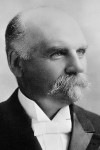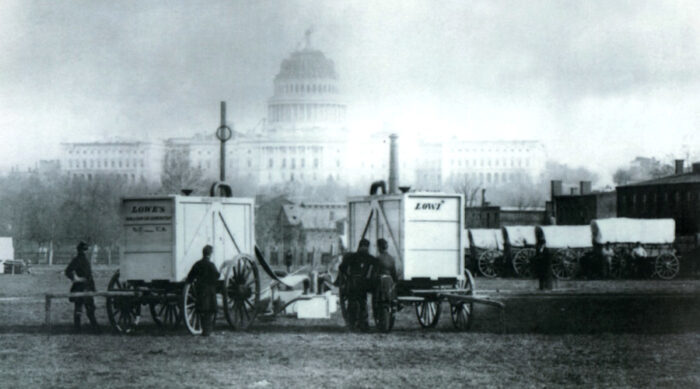
I am always trying to connect my two interests of Capitol Hill and airships. Sometimes even with some success. Sometimes, it takes a little more work. Like today.
Thaddeus S. C. Lowe was one of the country’s most famous balloonists at the outset of the Civil War, and so it was no surprise that he was interested in helping his country by using his skills. He came to Washington with his balloons and flew them a number of times, including from the lawn of the White House. He also sent telegraphic messages from above, showing how the information on enemy movements gleaned from above could immediately be transmitted. While there was general consensus that his work was good, there were other aeronauts vying for the job, and so no money was immediately forthcoming.
Lowe then made a number of balloon ascensions in Virginia, to see what the opposing forces were up to, as well as to prove the quality of his work. His most famous flight came on July 24, 1861, three days after the Battle of Bull Run. After the Union Army had been routed, there was some legitimate worry that the Confederate Army was now on its way to the nation’s capital. Lowe, from high above, was able to determine that this was not, in fact, the case, allaying fears in Washington.
Five days later, he received a brief message indicating that the army was willing to pay him for his services. After some negotiation, he also had the money to build a balloon, which he spent the following month building.
The biggest problem was that the only source for gas was Washington itself: It was necessary to transport the balloon fully filled to wherever it was to be used. As this was city gas, it did not have the lifting power of pure hydrogen. While Lowe had a plan to get around these two issues, it required some expert mechanics. Where to find them, but the Washington Navy Yard?

Under Lowe’s direction, the mechanics built a large wooden box on wheels. While the lower section was simply an ordinary army wagon, the box itself was anything but. The inside of the box was lined with copper, and there were two openings, one to allow iron filings to be poured in and spread out along the bottom. The box was then filled almost to the top with water, then topped off with sulfuric acid.
The chemical reaction between the iron and acid then produced quantities of hydrogen gas. This gas then passed out via a rubber tube into a further box filled with lime, which cleaned the hydrogen of any impurities before it flowed into the balloon.
While this seems pretty straightforward, it should be noted that it took some 5,000 pounds of iron and acid to produce enough to fill a balloon. On the positive side, it only took about three hours to finish the job.
By the end of 1861, six of these gas producers, finished off in light blue paint and the black lettering “Lowe’s Balloon Gas Generator” on them, were in the field and helping the Union Army observe their enemy.
Next week: Taking to the water.
